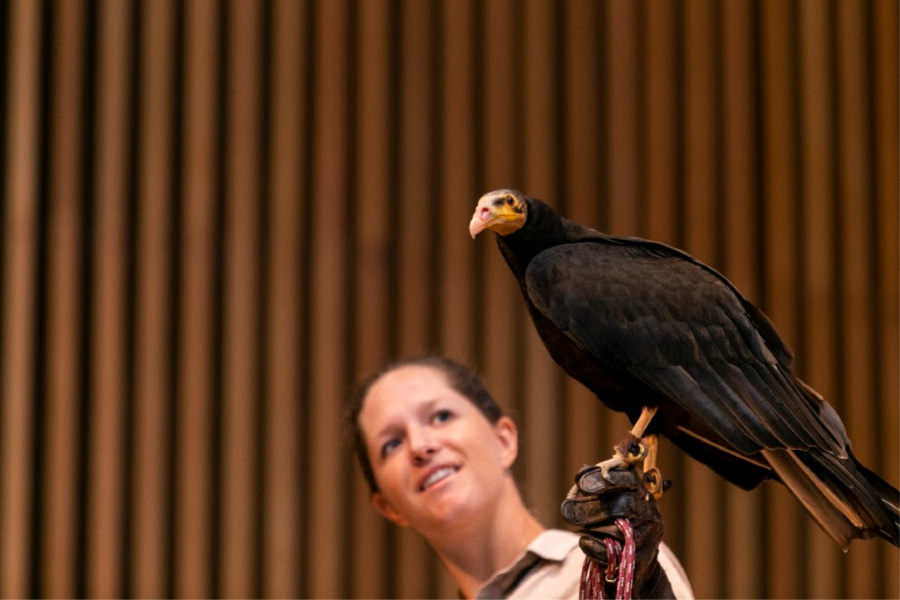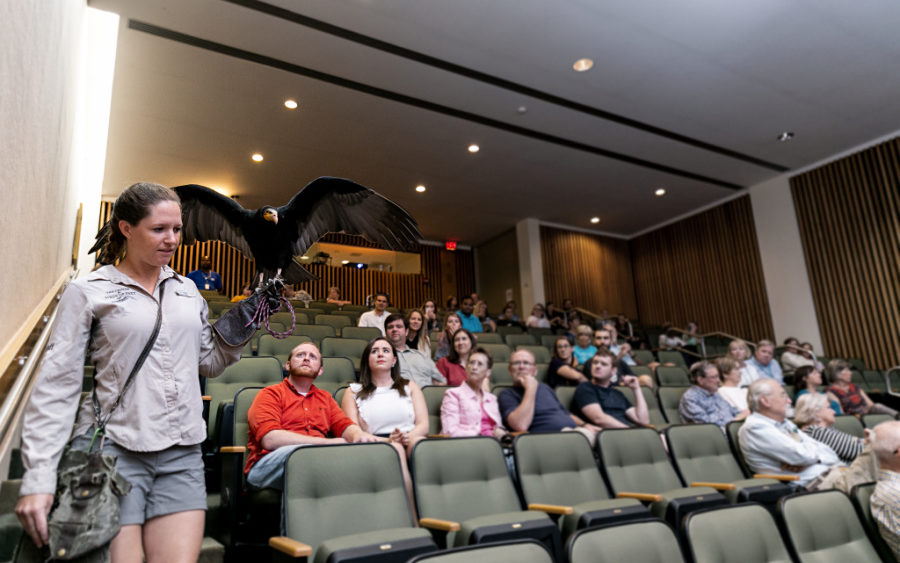On October 9, adult learners flocked to the second Holland Lifelong Learning lecture of the season. The Holland Lifelong Learning series introduces guests to issues that impact the environment locally and on a global scale. This lecture, “Scavengers and Thieves: Protecting Birds We Can’t Live Without,” highlighted the planet’s avian clean-up crew.
Stephen Schabel, director of education at the Center for Birds of Prey, oversees the training and care-taking of resident birds. In his fifteen years with the center, Stephen has come to realize that many visitors have a negative reaction when they hear the word “vulture,” and that their importance is not fully realized. What better way to learn and appreciate them than by seeing them up close! Schabel and his education team brought along four unique birds- a juvenile crested caracara (Caracara cheriway), lesser yellow headed-vulture (Cathartes burrovianus), black vulture (Coragyps atratus) and tawny eagle (Aquila rapax).
From specially adapted walking feet to featherless heads, these birds are designed to navigate large animal carcasses. Uniquely shaped beaks allow them to pull meat from different areas and in different ways. Despite common belief, some birds have a strong sense of smell. Perforated nostrils help these birds to smell dead animals far away and quickly arrive on the scene. Other birds, like eagles, will follow the lead of vultures to carrion sites.
The Center for Birds of Prey is a nonprofit organization that has treated 10,000 birds to date. Many of the ailments and issues that they see are caused by humans, from car accidents to intentional shootings.
Scavengers in other parts of the world face different threats. Examples include intentional poisoning by poachers who don’t want birds to draw attention to the carcasses they are harvesting, use in the bushmeat trade, demand due to the belief that one can inherit clairvoyant powers by ingesting vultures and unintentional poisoning due to eating livestock treated with pharmaceuticals.Although it’s easy to feel disconnected from these distant threats, it’s important to know that 60% of the world’s vulture populations are extinct. All parts of the world depend on this cleanup crew to maintain balance by eating animals that other predators are not equipped to. Here in the United States, there are three species of vulture and one, the California condor, is on the brink of extinction. You can help to protect these necessary scavengers by supporting organizations like the Center for Birds of Prey, and your local zoos and aquariums. 70% of the birds treated at the Center’s facility contained elevated levels of lead. The digestive system of scavenging birds breaks down lead and strengthens toxicity by 100%. Look for alternatives to lead shot, dispose of lead materials correctly (including your fishing tackle) observe and appreciate vultures and continue to learn more!This year, Holland lecture topics intersect with South Carolina Aquarium initiatives. As an accredited member of the Association of Zoos and Aquariums, the South Carolina Aquarium participates in the SAFE: Saving Animals From Extinction program. This program shines a spotlight on species with declining populations whose extinction could have irrevocable consequences. Many of the animals in the SAFE program are familiar to you, like sea turtles and sharks. Did you know that just this year the African vulture was added to the list?We hope to see you at the next Holland Lifelong Learning lecture! Check out the full series line up.Thank you to our sponsors Mary and Mason Holland, The Center for Birds of Prey, and the Charleston Museum.
You can help to protect these necessary scavengers by supporting organizations like the Center for Birds of Prey, and your local zoos and aquariums. 70% of the birds treated at the Center’s facility contained elevated levels of lead. The digestive system of scavenging birds breaks down lead and strengthens toxicity by 100%. Look for alternatives to lead shot, dispose of lead materials correctly (including your fishing tackle) observe and appreciate vultures and continue to learn more!This year, Holland lecture topics intersect with South Carolina Aquarium initiatives. As an accredited member of the Association of Zoos and Aquariums, the South Carolina Aquarium participates in the SAFE: Saving Animals From Extinction program. This program shines a spotlight on species with declining populations whose extinction could have irrevocable consequences. Many of the animals in the SAFE program are familiar to you, like sea turtles and sharks. Did you know that just this year the African vulture was added to the list?We hope to see you at the next Holland Lifelong Learning lecture! Check out the full series line up.Thank you to our sponsors Mary and Mason Holland, The Center for Birds of Prey, and the Charleston Museum.


